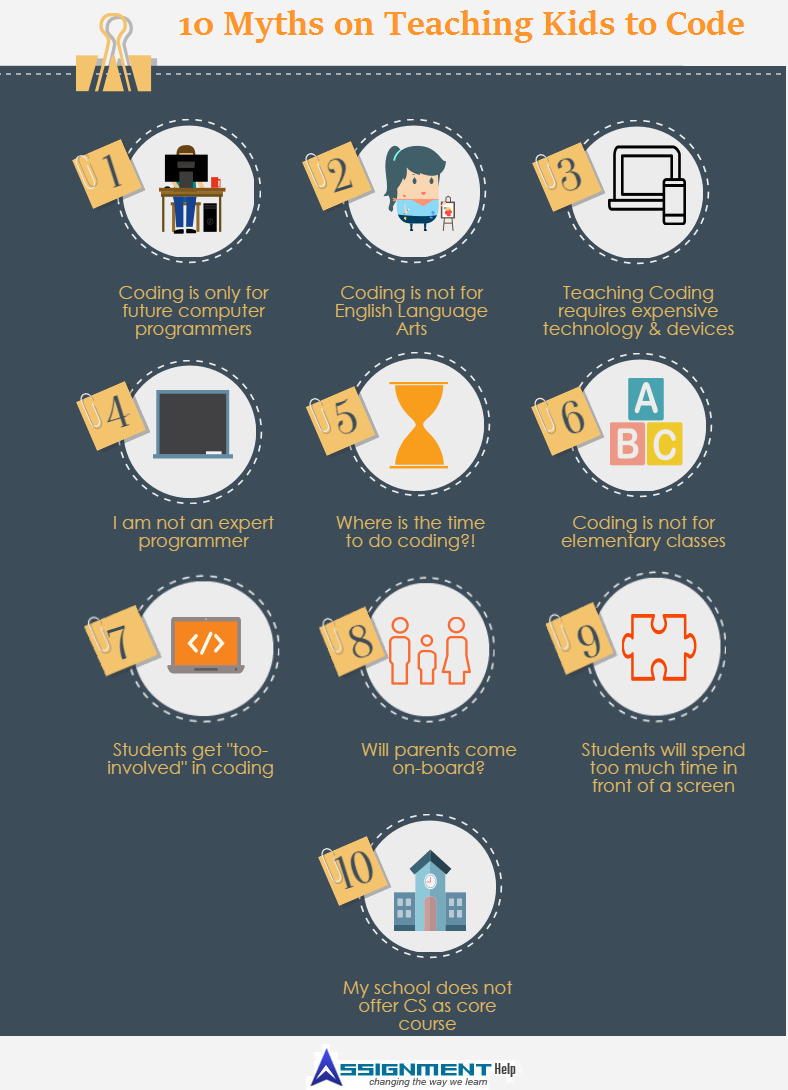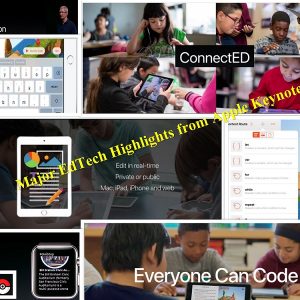10 Doubts Teachers have About Teaching Coding
According to a recent Gallup research a surprising 85% of parents, 75% of teachers and 68% of principals say that computer science education is “just as important” or “more important” than teaching required courses like math, science, history and English. Yet, over 25% of schools do not have access to computer classes or computer clubs of any time.
Here are a few myths that might be holding teachers form integrating coding literacy in their curriculum.
 To Embed this Infographic on your website simply copy the code below [snippet id=”1852″]
To Embed this Infographic on your website simply copy the code below [snippet id=”1852″]
Coding should be taught only to those students who aspire to become computer programmers.
FALSE: Saying this is tantamount to saying that writing should be taught only to those who wish to become a novelist. While careers in computer science are themselves abundant and pay handsomely, knowledge of computer and information technology are becoming all pervasive in every field of work. By 2020, almost every job description would enlist one or the other computer or information technology based skill as a requirement. Thus, by teaching kids to code we are future proofing them. Also, learning coding develops problem solving skills with critical thinking, computational logic in students. Students learn to execute solutions that are accurate yet precise and scalable. Coding classes inherently embody principles of inquiry, project based learning and maker education.
But I am an English Language Arts teacher!
No Worries: Computers have long learnt to speak the language of arts educators, however most language and arts educators still continue to teach solely with traditional media. The current ease of use, versatility and relevance as well as opportunities for professional learning and collaboration have left integration of computer programming into arts and language education classes as long overdue. Commercial arts such as illustrations, architecture and interior designing, advertising, media, animation, publishing as well as product designing are now all done on computers. Thus, teaching kids functional languages such as JAVA, C++ as well as visual design oriented languages such as Processing will allow them to tap into design skills for commercial art employment.
In literature programs, many educators are bringing in programming for analyzing text, checking plagiarism, detecting literary features such as alliteration, rhyming, homophones as well as for doing text to speech analysis, parsing sentences, words, syllables as well as part of speech and phrases and computational linguistics for Natural Language Processing . At junior class levels, coding for story-telling makes a great way to bring enthusiasm in dry boring literature classes.
Teaching Coding requires expensive technology and expensive smart devices.
SEMI-TRUE: Integrating technology into classroom is required for teaching coding to students, especially beyond a certain introductory level. However, initially coding can be introduced into classrooms in economical (even free) ways. Teachers can utilise resources, lessons and tutorials from Code.Org; iPad based apps such as Tynker, Codea, Hopscotch, LightBot to teach the basics of coding and programming logic to kids. Scratch & Scratch Jr, Alice, Kodu and Minecraft are some other PC and tablet based software suitable for kids of middle school and high school age. In terms of hardware, Raspberry Pi and Hummingbird Robotics kits are relatively inexpensive (for $100 or less) and highly useful. Also, there is no need for every child to have his or her own device to learn coding skills. Collaborative coding projects such as pair programming are even better at enhancing problem based and communication skills of students.
I am not in expert programmer, how can I teach coding to my students!
FALSE: Most teachers hold back on bringing coding in their classroom as they themselves are not expert programmers. Today there are many coding kits that do not require teachers to have any coding experience or training. These kits come complete with the problem puzzles and gamified topics, flow of instructions and knowledge of coding skills that are required to help imbibe computational thinking. There are various self-learning oriented tools such as Scratch that are quick to learn-as-you-progress and require teachers to act only as facilitators and guides rather than ‘teachers of computer programming’. The technical knowledge, codes and program flows are integrated as visual cues, walk-throughs, tutorials and interactive lesson plans in mostly all such apps and programming tools. It is easy for teachers to teach and learn simultaneously, the basics of coding and computational thinking. These kits allow teachers to spend more time helping and mentoring students rather than spending too much time in preparing coding based lesson plans. Gradually, school administrations can look for training partners to fund coding literacy for teachers as well as to provide training to make teachers proficient in teaching coding.
Where is the time to do coding?
NOT TRUE: Teachers hesitate to integrate coding into their classroom as they do not wish to burden an already compressed classroom teaching time. This naïve thought is a consequence of thinking coding as only a domain of computer science classes; distinct and unrelated to other subjects. Coding need not be taught as a separate specialised subject, especially since the early grade. It can be easily integrated with other subjects such as Math, Science, Arts, History; making those subjects even more practical, relevant and engaging. Cracking the code – the correct answer is “hybrid”.
While many schools offer computer science as a subject by itself, the larger CS curriculum can be easily integrated with the existing curriculum of subjects such as Math, science, English language arts, social studies including the common core state standards. Teachers can introduce various such drop-in replacements for existing courses and tap into students’ excitement around gaming and bringing their self-coded creations to life. Coding resources such as Tynker have readymade grade-specific coding projects that can be easily integrated into classroom teaching. Students can use coding to create history timelines, storyboards in English classrooms or solve coding block puzzles for learning fractions and algebra. There are many more coding literacy resources and initiatives that offer fast, easy and student-teacher friendly ways convert abstract on-paper problems into engaging programming games, puzzles and real-life simulations.
I teach elementary classroom kids, I need not bother!
STILL YOU CAN: It is a false notion that only middle and high school age students can learn coding. Teaching coding to elementary school age students is not only easier but also more rewarding. Sooner the children are taught to orient their thought process with logical and computational skills, more comfortable they will be with the learning opportunities in higher grades. Recent research pointed out that children aged five to 16 spend an average of six and a half hours a day in front of a screen. With coding, students can be taught to productively utilize their screen time to learn and create new things and explore project-based learning instead of loitering around wasting time online. So next time send a homework that requires kids to code their turtle to move around for addition and subtraction or simply create repeating loops to understand multiplication, kids would be happy to do it.
Students get too-involved in coding and forget the actual underlying concept.
Here is What to do: Some teachers who have successfully integrated coding into their classroom do face this challenge. Coding by itself is such a rewarding yet vast experience that it is easy for students to get engrossed in learning only coding at the expense of learning by coding. In a hybrid classroom it is important for teachers to actively and routinely manage the learning by coding process. Teachers can prepare various checkpoints at which students must turn in whatever work ( or screenshots of their codes) they have done thus far. This will be helpful even for tracking and eliminating bugs periodically. Also the teachers can stay in the loop and students will never loose focus of their learning goals.
Can I get the parents on-board with me?
Absolutely! Getting parents on board with you in your endeavour to being coding to classroom would be crucial. Parents would be able to help and encourage their children in learning coding skills at home. There might also be some parents who themselves would be willing to help you with their own coding knowledge, resources and learning activities for teaching coding in classroom. Seek out their help, invite them to speak with students, inform and inspire them with different coding-career choices and explore learning possibilities to make all kids coding literate.
We do not want students to spend too much time in front of a screen.
No Worries: There are various offline puzzles, logic games and multiplayer board games that can be used to teach coding skills offline without any distractions and technicalities of learning coding on computers. Unplugged coding activities provide students more hand-on experience in building and executing their programs. Also offline coding without the aid of blocks and computer tools gives students better exposure to the actual experience of steps and logic involved in coding. There are several engaging games (even outdoor games), DIY project ideas and puzzles that can teach coding without any screen time in a much more cost-effective manner. For related activities and resources teachers can also check out CS Unplugged which has a collection of free learning activities that teach Computer Science through engaging games and puzzles that use cards, string, crayons and lots of running around. Robot Turtles Game for ages four and up this game lets kids write programs with cards. This game has gotten a lot of great reviews and teaches kids programming inspired by the LOGO programming language.
Should I demand my school to teach Computer Science as a Core subject to all grades and all students?
You MUST ! It was stated right in the beginning that 85% of parents, 75% of teachers and 68% of principals say computer science is just as important as or more important than the core subjects taught in school now. Yet, only a quarter of schools nationwide offer it. 25% of the schools have no access to a computer science class or club at school.
Providing computer science as a core subject in schools is not just a means to promote coding literacy. It is also an effective tool of bridging a digital divide. Offering computer science classes by itself or as integrated classroom coding programs will afford many students of lower socio-economic backgrounds an equal opportunity to learn computer technology and utilise computational skills for creative engagement.
As I said right in the beginning, teaching coding and programming skills is not just for the future computer engineers. Coding literacy is now as fundamental as reading, writing and arithmetic. All future careers are going to utilise knowledge of computer skills in some form. It should be a priority of every school to offer computer science training to students of all grades. Kids of all age are excited by the prospect of learning to code, whether in their CS curriculum or as hybrid classroom concepts. Millennial students want to learn coding. They want to create things of their own using their mobile devices and PCs. Apart from the actual learning outcomes, there are other latent benefits of computer science teaching such as logical thinking, problem solving, communication skills, collaborative development.
Also check out our post on Programmable Toys that can be used to teach coding.
Looking for a perfect Holiday Gifts for your Girls? Discover our guide for perfect STEM based Gifts for Girls.


